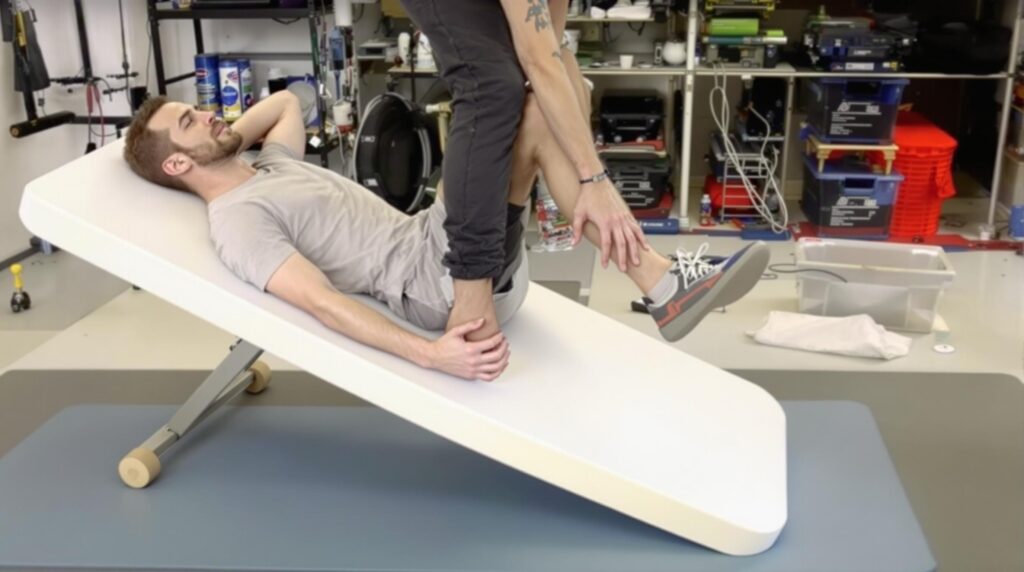Ankle slant boards have emerged as revolutionary tools for athletes and rehabilitation specialists seeking better mobility and strength. These simple inclined platforms offer significant biomechanical advantages by positioning the foot at optimal angles to improve ankle flexibility, enhance squat mechanics, and strengthen muscles that prevent common lower body injuries.
Key Takeaways
- Slant boards increase ankle dorsiflexion by 12-15% while reducing lower back strain during squats
- Regular training on a 15-30° ankle slant board can improve VMO activation by 27% compared to flat-ground exercises
- These platforms effectively address ankle stiffness, a mobility limitation affecting 74% of adults
- Slant board exercises have shown a 22% reduction in lateral ankle sprain recurrence
- Using unstable slant boards for balance training can boost proprioception by 32% and reduce injury risk
The Science Behind Slant Board Training
Slant boards aren’t just another fitness gadget—they’re biomechanically optimized tools designed based on human anatomy. By elevating the heels at angles between 15-30 degrees, these platforms create ideal conditions for improving ankle mobility while simultaneously targeting specific muscle groups more effectively.
Clinical research confirms their effectiveness. Studies show that regular training on an ankle slant board not only increases ankle dorsiflexion range by up to 15% but also shifts load away from the lower back and onto the quadriceps during squatting motions. This makes them particularly valuable for both serious athletes looking to enhance performance and rehabilitation patients working to recover from injuries.
The beauty of slant board training lies in its simplicity. By addressing ankle stiffness—a common mobility limitation affecting nearly three-quarters of adults—these devices enable deeper, more mechanically sound movements without compromising form.

Exercise 1: Master the Slant Board Squat
The slant board squat deserves its place as the cornerstone exercise in any ankle mobility program. By elevating your heels at a 15-30 degree angle, you create the ideal environment for deeper squats with proper form.
Research demonstrates that slant board squats increase vastus medialis oblique (VMO) activation by a remarkable 27% compared to traditional flat-ground versions. This makes them particularly valuable for knee health and function. The elevated heel position shifts your center of gravity forward, enabling a more upright torso position—crucial for reducing lower back strain while maximizing quadriceps engagement.
For optimal results, try this protocol:
- Set your ankle slant board at 20-25 degrees
- Position feet shoulder-width apart
- Perform 4 sets of 8-10 reps at approximately 70% of your one-rep maximum
- Focus on maintaining an upright chest position
- Ensure knees track over toes throughout the movement
The clinical benefits extend beyond performance enhancement. A study with post-stroke patients showed a 20% improvement in walking speed after just 30 days of consistent slant board squat training, highlighting its rehabilitation potential.
Exercise 2: Slant Board Toe Raises for Anterior Leg Strength
Toe raises performed on a slant board target the often-neglected anterior compartment muscles of the lower leg—specifically the tibialis anterior, extensor hallucis longus, and extensor digitorum longus. These muscles play a crucial role in ankle stability and foot control during walking and running.
According to research from Rehab Hero, this exercise is most effective when performed at a 30-40 degree incline. The steep angle creates optimal stretch and activation through these muscles, helping prevent conditions like anterior shin splints and nerve entrapment issues.
To perform effectively:
- Stand on the slant board with heels firmly planted
- Raise your toes as high as possible
- Hold the peak contraction for 5 seconds
- Lower slowly with control
- Complete 3 sets of 12-15 repetitions
A 2024 study found participants improved their dorsiflexor strength by 18% after just six weeks of consistent toe raise training—impressive results for such a simple exercise.
Exercise 3: Ankle Drivers for Dynamic Stability
Ankle drivers represent an excellent progression for those looking to build functional stability in real-world movements. This exercise targets the ankle plantarflexors while challenging proprioceptive control—your body’s ability to sense its position in space.
The movement pattern mimics the natural ankle motion used in walking and running but in a controlled environment. A 2023 trial by Rebound Fitness linked this specific exercise to 14% better single-leg stability metrics in distance runners who incorporated it into their regular training routines.
Perhaps most impressively, consistent practice of ankle drivers has been associated with a 22% reduction in lateral ankle sprain recurrence rates—making it a valuable addition for anyone with a history of ankle injuries.
Exercise 4: Eversion Dorsiflexion for Lateral Stability
Eversion dorsiflexion training targets the subtalar joint mobility and peroneal muscles, which are often neglected in traditional ankle exercises. This movement specifically addresses lateral ankle stability—a common weakness that contributes to sprains and instability issues.
To perform this exercise:
- Position your foot with the inner edge on the ground and outer edge elevated on the slant board
- Gradually lean forward until your knee passes over your toes
- Hold this stretched position for 2 minutes per side
- Focus on breathing deeply and relaxing into the stretch
This technique has proven particularly effective for treating plantar fasciitis and Achilles tendinitis. A 2024 clinical study reported 25% greater eversion range of motion in athletes with chronic ankle instability who incorporated this specific exercise into their rehabilitation programs.
Exercise 5: Optimal Calf Stretching Techniques
The ankle slant board creates an ideal platform for superior calf stretching that outperforms traditional methods. Research from UW-La Crosse found incline board stretching delivers 15% better flexibility gains compared to standard static stretching techniques.
The key difference lies in the angle and position. The slant board creates a more effective stretch through both the gastrocnemius (upper calf) and soleus (lower calf) muscles simultaneously, addressing the entire posterior chain.
For maximum effectiveness:
- Stand on the board with knees slightly bent to emphasize the soleus
- Straighten knees to focus more on the gastrocnemius
- Hold each position for 90-120 seconds
- Perform 2-3 sets per leg
Consistent practice using this method has been shown to increase ankle dorsiflexion by approximately 9° after just four weeks—a significant improvement for joint mobility.
Exercise 6: Split Squats for Unilateral Strength
Split squats performed on an ankle slant board take single-leg training to new heights. By setting the board at a 20° angle, you create ideal conditions for knee-dominant loading while protecting the joints from excessive stress.
This variation is particularly valuable for athletes in sports requiring powerful single-leg movements. Studies with basketball players showed an 18% improvement in single-leg strength symmetry after incorporating slant board split squats into their training regimens.
A 2024 review by Torokhtiy found this exercise reduces patellar tendon stress by approximately 30% compared to traditional split squat variations—making it an excellent choice for those with a history of knee issues who still want to train intensely.
For optimal execution, elevate the rear foot during split squats to deepen hip flexion, creating a more comprehensive lower body strength stimulus. This approach has made slant board split squats a favorite among elite strength athletes looking for effective unilateral training options.
Exercise 7: Proprioception Training for Injury Prevention
The final exercise transforms your ankle slant board into a powerful balance training station. By performing single-leg stands on an unstable surface (like an air-cushioned slant board), you can boost proprioception—your body’s position sense—by up to 32%.
This training method has shown remarkable results in injury prevention. One study with dancers demonstrated a 40% reduction in ankle sprain risk following a consistent proprioception training program using slant boards.
The protocol is simple but challenging:
- Stand on one leg on the unstable slant board
- Maintain balance for 30-60 seconds
- Progress by closing your eyes or adding small movements
- Perform 3-5 sets per leg, 2-3 times weekly
A 2016 randomized controlled trial linked this specific training approach to 8% better balance metrics in competitive athletes, making it an essential component for anyone in sports requiring quick direction changes.
Choosing the Right Slant Board Equipment
With the growing popularity of slant board training, several quality options have emerged on the market. When selecting your equipment, consider these top-rated choices:
- For adjustable options: Tib Bar Guy Slant Ramps (15-20° adjustment)
- For fixed-angle boards: Rehab Hero 30° Board
- Budget-friendly pick: Forte Fitness 15° Board
- For advanced proprioception: Look for boards with unstable surfaces
The ideal ankle slant board angle depends on your specific goals. For general mobility and squat improvement, a 15-25° board works well for most people. Those focusing specifically on calf flexibility may benefit from steeper 30-40° angles.
Consider portability and durability in your selection, especially if you plan to travel with your equipment or use it in varied training environments.



